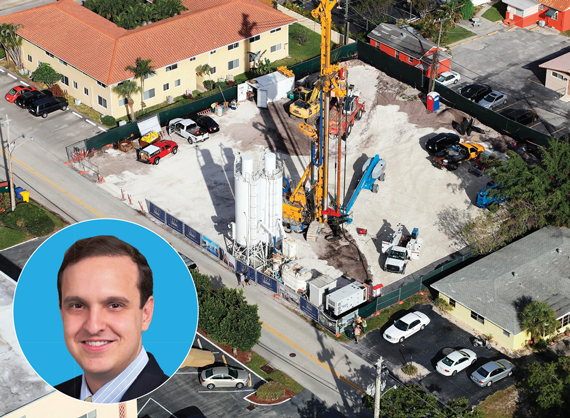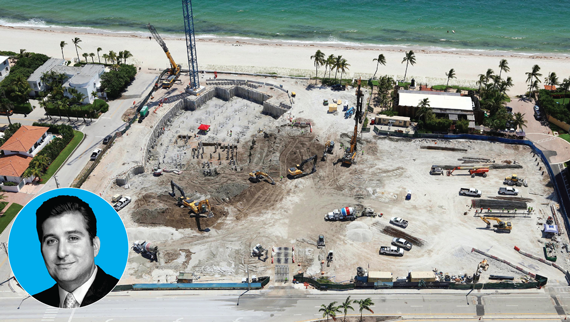South Florida condominium sales have been at high tide for years, but the low tide may be just on the horizon — if not ashore — amid mounting evidence of overbuilding and declining demand. Real estate experts say that if preconstruction condo sales keep falling, a slowdown in construction financing will follow.
Wells Fargo Bank Senior Vice President Patrick Ramge, who oversees commercial real estate lending throughout Florida, has lowered the expectations for his bank’s condo construction lending in 2017 in the state. “It’s not going to be as big as previous years have been for Wells Fargo,” Ramge said. “Presales in South Florida have definitely slowed down.”
Until recently, sales were propped up by demand from foreign buyers, but their interest in the Florida condo market has ebbed as currency exchange rates have turned against them. Real estate analyst Jack McCabe, based in Deerfield Beach, said that over the last few years the foreign condo buyers had “created a bottom and started pushing prices back up, but it wasn’t going to last forever.”
A sobering midyear report on the state of the condo market in downtown Miami showed that the average resale price of condos dropped 4 percent in the first half of 2016, following five consecutive years of double-digit growth. Preconstruction sales of downtown condos have also slowed, with the number under contract or reservation falling to 1,552 at midyear, down 25 percent from the end of 2015, according to a report by Integra Realty Resources for Miami’s Downtown Development Authority.
“There is a fair amount of market speculation that new construction debt is getting too expensive, and may become inaccessible for new construction in the coming quarter,” the report said.
Anthony Graziano, senior managing director in Integra’s Miami office, said that few commercial banks are funding condo construction in South Florida, so developers have limited options. “The conventional sources of development financing are getting a lot more expensive because there are fewer and fewer players in the market to put any downward pressure on rates,” he said.
 Graziano said banking regulations have contributed to the limited number of banks active in this segment. “The balance-sheet reserves that conventional banks have to keep to stay in compliance is forcing the banks to move away from construction,” he said.
Graziano said banking regulations have contributed to the limited number of banks active in this segment. “The balance-sheet reserves that conventional banks have to keep to stay in compliance is forcing the banks to move away from construction,” he said.
Here is an overview of the key lenders active in the South Florida market, including nonbank lenders such as private equity funds.
The nonbanks
Larger condo developers may be able to negotiate more favorable terms with nontraditional sources of construction financing.
Consider the $132 million loan that nonbank lender TPG Real Estate Finance made to Florida’s biggest condo developer, Miami-based Related Group, in August of this year. The loan finances construction of the two-tower oceanfront development called Auberge Beach Residences & Spa Fort Lauderdale. The preconstruction condo buyers include Related Chairman and CEO Jorge Perez and former Miami Dolphins quarterback Dan Marino. By the end of August, the north tower of Auberge was 90 percent presold, but the south tower was only 30 percent presold. Combined, the north and south towers will have 171 units.
“You wouldn’t be able to go out and finance a tower on its own at 30 percent,” said Ben Gerber, vice president of finance at Related Group. But TPG essentially financed the construction of both towers in a single loan agreement, he said, “given the profitability of the development and the strong presales in the north tower.”

Group P6 is building 327 Royal Palm, a 25-unit boutique condominium tower in Boca Raton,
with fi nancing from Banesco. Inset: Ignacio Diaz, general manager of Group P6.
TPG has made condo construction loans for several other Related projects. “They are the former Deutsche Bank special-situations group,” Gerber said. “When they were with the DB platform, we did a few deals with them in the downturn, all distressed deals.”
Another nonbank lender, Dallas-based Hall Structured Finance, extended a $35.6 million construction loan in August to build Gale Residences Fort Lauderdale Beach, a 12-story, 129-unit condo building. “The number of lenders in the segment is limited, so they tend to be more expensive,” said Harvey Hernandez, a principal with the project’s developer, Newgard Development Group.
Howard Taft, a senior managing director of Coral Gables-based Aztec Group, arranged the construction loan for Gale Residences. He said it took six months to settle on Hall after discussions with multiple lenders. “We talked to banks, credit companies, private investors, pretty much the gamut,” he said. “All of them wanted presales equal to or greater than the loan amount.”
Taft said presales for Gale Residences total $60 million, and called the project’s construction loan “one of the last condo construction loans in this cycle.”
Other nonbank lenders active in condo construction lending in South Florida include New York City-based Mack Real Estate Group and Los Angeles-based Canyon Partners Real Estate. “Canyon Capital has been very active in condo construction,” Taft said. “They’re also conservative and very diligent in their underwriting and totally understand condominium construction lending.”
The big banks
Taft said national banks, such as Bank of America and Wells Fargo, typically only extend condo construction loans to the largest and most successful developers. “They’ll only lend to Swire, Related, Galbut, PMG,” he said. “The big names in town.”
Some large regional banks are players, too. Arkansas-based Bank of the Ozarks is one of the most active lenders in the Florida condo construction market. “They have been one of the more aggressive and creative — at the same time conservative — construction lenders for condominiums in this cycle,” Taft said. “They are extremely knowledgeable and understand this space where other banks don’t understand condominium construction lending.”
 Among Ozarks’ construction lending for South Florida condo developments: a $63 million loan for the 95-unit Paramount Fort Lauderdale Beach project, a $70 million loan for the 513-unit Canvas in Miami’s Arts & Entertainment District, a $93 million loan for the 317-unit GranParaiso in Miami’s Edgewater area and a $95 million loan for the Ritz-Carlton Residences in Miami Beach, which has plans for 111 condos and 15 single-family homes.
Among Ozarks’ construction lending for South Florida condo developments: a $63 million loan for the 95-unit Paramount Fort Lauderdale Beach project, a $70 million loan for the 513-unit Canvas in Miami’s Arts & Entertainment District, a $93 million loan for the 317-unit GranParaiso in Miami’s Edgewater area and a $95 million loan for the Ritz-Carlton Residences in Miami Beach, which has plans for 111 condos and 15 single-family homes.
George Gleason, chairman and chief executive officer of the publicly held Bank of the Ozarks, said during a conference call with analysts in July that the bank’s condo construction loans in South Florida are conservative because they equal about a third of the project costs.
“Our average loan to cost on those projects, assuming every loan is fully funded, is 36 percent loan to cost,” Gleason said.“There are sizable presales that ensure the exit of our financing in every transaction, even if some of the presales fall out.”
Local banks
Few, if any, community banks in South Florida are big enough to satisfy the construction financing needs of huge projects by developers such as Related. Yet some of the region’s homegrown banks are active in the condo construction loan market.
Biscayne Bank in Miami, for example, provides residential construction loans, especially for townhouse developments. “We don’t see a lot of downside to these small developments,” said Thomas Lumpkin, the bank’s chairman.
Biscayne Bank’s construction loans to townhouse developers average about $2 million each. “We have a $15.5 million legal lending limit for real estate, so we could do a small condo project on our own,” Lumpkin said. “But we don’t have the appetite to do that.”
Another local bank, the Coral Gables-based Banesco USA, committed financing for the construction of a 25-unit boutique condo project in downtown Boca Raton. Banesco loaned $19.7 million to Boca Raton-based Group P6 to build 327 Royal Palm, with unit prices starting at $1.6 million and unit sizes ranging from 3,100 square feet to 7,000 square feet.
Group P6, which bought the half-acre development site in 2014 for $2.7 million, expects to finish construction of 327 Royal Palm by the end of 2017. Ignacio Diaz, general manager of Group P6, said the Boca condo project is 50 percent presold — a requirement of Banesco to finance the project’s construction. He said that some lenders did not require such a high level of presales. “Not all the lenders were asking 50 percent,” he said. “There were some lenders willing to go below that.”
Diaz said he thought the location in downtown Boca Raton was attractive to financiers. “We’re not in Miami, where lenders are sort of backing off,” Diaz said. “Our buyers are Americans. We don’t have currency exchange issues.”
He said Group P6 had considered a loan from a private equity fund. “They are easier to deal with, less paperwork, faster closing time,” he said. “But more expensive in the end.”
